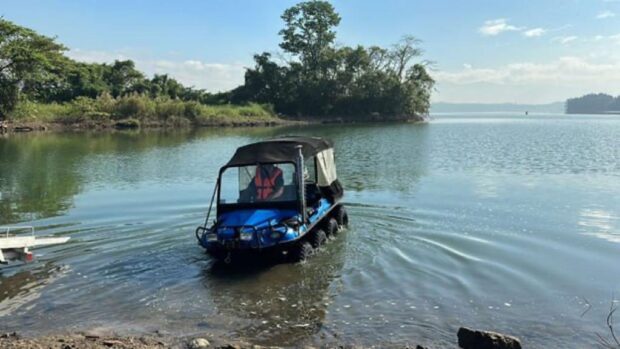
An amphibious vehicle being tested at La Mesa Dam. This vehicle is part of Manila Water’s contingency fleet for quick response during typhoons and other emergency scenarios.
MANILA, Philippines — Manila Water took steps months before the Philippine Atmospheric, Geophysical, and Astronomical Services Administration (Pagasa) declared the start of the rainy season this month to ensure its facilities can continue operating during heavy rains, flooding, and power outages.
In preparation for powerful typhoons, Manila Water has prepared its three primary Quezon City water treatment plants. Each facility has generators for power interruptions.
Moreover, sandbags and dewatering pumps have been placed to address potential flooding. Manila Water’s water treatment plant personnel adhere to a strict protocol, which includes securing system backups, fuel, batteries, medical and first aid supplies, food, and other emergency items.
Regular maintenance and preventive measures have been conducted on 48 water pumping stations and 41 reservoirs to prevent downtime.
Metro Manila’s East Zone is home to eight of Manila Water’s emergency reservoirs, stocked with drinkable water and ready for use in a natural disaster or typhoon.
These emergency reservoirs are strategically located at Amoranto Stadium, Pinyahan Elementary School, Project 6 Elementary School, Quirino Elementary School, and Emilio Aguinaldo in Quezon City.
Additionally, emergency reservoirs have been set up at Cainta Elementary School in Barangay San Roque, Cainta; Mayamot Elementary School in Antipolo City; and San Juan Elementary School in San Juan.
Manila Water has augmented its mobility by deploying emergency vehicles to bolster its response capabilities during disaster scenarios.
The water company’s emergency fleet comprises four mobile treatment plants, a mobile stage, a mobile command center, a mobile toilet, a mobile sleeping quarter, an amphibious vehicle, a tractor head, six 4×4 rescue vehicles, an ambulance, an all-terrain vehicle, a jet ski, three-speed boats, and five folding boats.
In addition, Manila Water has conducted testing and maintenance on its wastewater and sewerage systems to ensure efficient sewer and sanitation services for its 7.6 million customers in the East Zone of Metro Manila and parts of Rizal.
The company has prioritized the optimization and flood resilience of its 22 sewage pumping stations, 46 sewage lift stations, and 27 wastewater treatment facilities, many located near or along riverbanks.
“Manila Water continues to work closely with the MWSS to ensure that capital expenditure projects are on track and will be completed as scheduled to sustain the 24/7 water and sanitation services even during the rainy season,” Corporate Communications Affairs Group Director Jeric Sevilla said.
RELATED STORY:
Manila Water customers assured of 24/7 supply